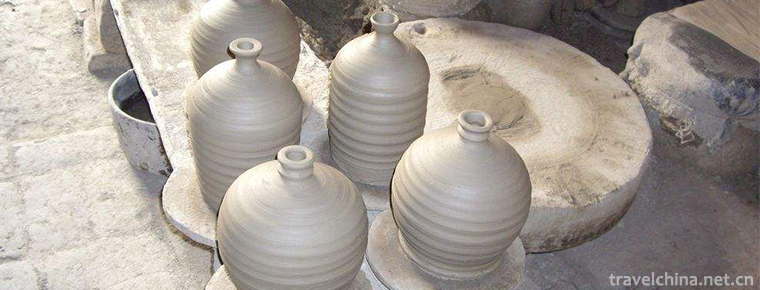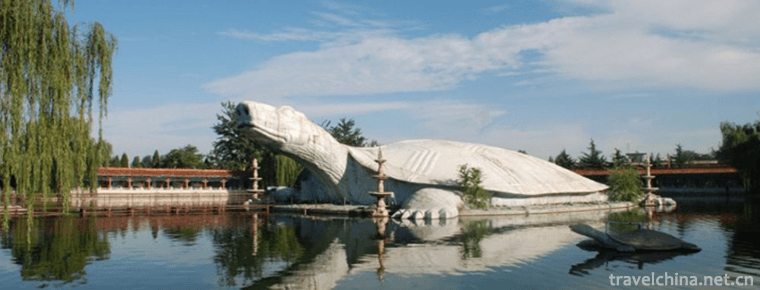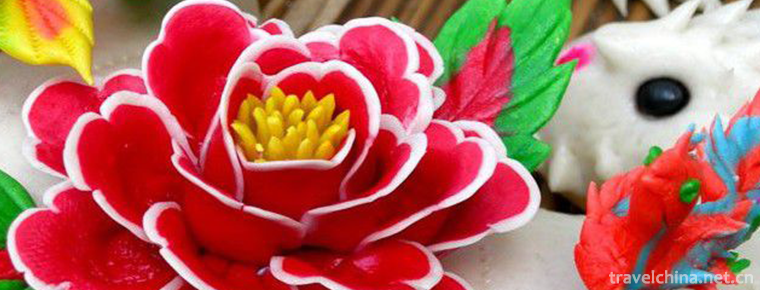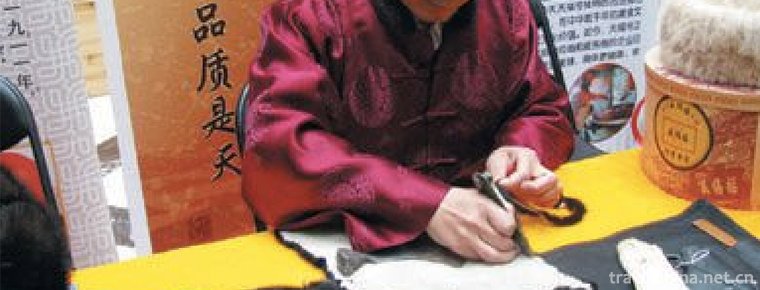Sintering Techniques of Chengcheng Yaotou Ceramics
Sintering Techniques of Chengcheng Yaotou Ceramics
Yaotou Ceramic Firing Skill in Chengcheng, a traditional handicraft in Yaotou Town, Chengcheng County, east of Guanzhong, Shaanxi Province, is one of the national intangible cultural heritages.
Chengcheng Yaotou ceramics has a history of more than 1300 years of firing. All the firing techniques are manually produced by soil method. The raw materials are collected from local crucible soil. The processing process includes mud, billet making, glazing and calcination. The process is simple and generous in shape, simple and crude in skeleton, pure and precise in glaze color.
On May 20, 2006, the firing technology of Yaotou ceramics in Chengcheng was approved by the State Council and listed in the first batch of national intangible cultural heritage, numbered_-12. In May 2018, the firing technology of Yaotou ceramics was listed in the first national catalogue of inheritance process revitalization.
historical origin
Chengcheng ceramics are mainly produced in Yaotou Town. According to the Record of Chengcheng Geographical Names, Yaotou Town was named "Yaotou Town" in ancient times because of its many porcelain kilns and because the ancient sage "Yao" pronounced the same as "Yao", the character of "Yao" gradually replaced the "kiln" of the porcelain kiln. The name of Yaotou Town has been used for a long time.
Yaotou coarse ceramics is a famous folk ceramics kiln in the history of Weibei, Shaanxi Province. Its kiln site is also an important place of the folk ceramics culture relics of past dynasties. According to the Ming Dynasty County Records, Chengcheng "Porcelain Sand Begins in Tang Dynasty". This is the earliest written record of Yaotou kiln. From 1522 to 1566 (Ming and Jiajing years), the County Chronicle once recorded the Levy of kiln tax, and every year "the kiln levies 289 coins and 500 articles... Products: Black porcelain and carbon for utensils. Hei Ci Yaotou Town specialty. "Tongzhou Prefecture chronicles" printed in 1625 (five years of Tianqi in Ming Dynasty) also records: "Chengcheng Yaotou... Ceramic magnets." Chengcheng kiln can also produce celadon in the trend of the disappearance of celadon in the north after Yuan and Ming dynasties. This phenomenon is extremely rare in the northern kiln, which adds a strong stroke to the determination of the historical status of Chengcheng kiln.
During the Ming and Qing Dynasties, the ceramic industry in Yaotou Town developed to a flourishing stage. According to Chinese folklore, in its heyday, there were more than 100 kilns and more than 2.2 million pieces of ceramics annually, which not only occupied the market of Weibei counties, but also exported to Shanxi, Gansu, Inner Mongolia and Northern Shaanxi.
From the end of the Qing Dynasty to the beginning of the Republic of China, owing to the war and banditry, and the influence of famine in 1877 (three years of Guangxu), the population of Chengcheng County declined sharply, and Yaotou's ceramics industry declined seriously. In 1926 (the fifteen years of the Republic of China), Chengcheng County Chronicle recorded that "the domestic technology is not prosperous. No other specialty. The famous pottery and sand wares of Changrun Town (Yaotou) are everyday objects. There were more than 40 old kilns, more than 20 in the fifteenth year of the Republic of China, and more than 30 kilns were produced annually. At that time, the production number was "about 30 strings of value per kiln, about 10,000 strings of money per year", and the scale and production process of the porcelain industry were recorded in more detail. In 1926 (the fifteenth year of the Republic of China), the number of fired ceramics decreased from more than 40 to more than 20. It is known that only half of the scale of the Qing Dynasty was reached at that time.
Process characteristics
Glaze color
The glaze color of Chengdi Yaotou coarse porcelain is mostly white, blue and black. Besides white and yellow, there are also blue and brown-red patterns, such as bowls, dishes or white glazed orchids, tribute yellow glazed rust flowers, monochrome hand sketches, simple and generous. Flowers and animals decorated on various utensils have the same origin as paper-cut and face-flower designs in local areas. The contents are mostly lotus, peony, chrysanthemum or Fu, Lu, Shoushou, Xi and so on.
decorate
In addition, the decorative art of Yaotou Porcelain is also very exquisite, including black glaze engraving, black glaze engraving, white glaze rust, white ground blue, yellow subway rust, blue glaze engraving, among which iron embroidery and engraving are the most brilliant. The rust flower is one of the representative decorations of Yaotou kiln, which is made of iron oxide-containing paints, flowers and patterns painted on the ceramic body with white makeup clay or black, yellow and green glaze, followed by transparent glaze. The patterns of five, six, seven, eight, nine-point plum blossoms, chrysanthemum and butterfly are mostly concise, bold and free to sprinkle.
Sculptured flowers are carved with bamboo pen on the ceramic body with white makeup clay or black glaze, revealing the background color of the ceramic body, and fired at 1500 degrees high temperature, forming a strong decorative effect of black-white and gray-white contrast. The patterns are mostly auspicious patterns with profound implications, such as pomegranate, Xiantao, Tianma, Tuanhe, Bagua, chrysanthemum and other patterns. The pen and knife are fluent, full of emotion, ever-changing and vigorous, with the feeling of looking forward to life and dancing, and reach the exquisite artistic level.
Technological process
Yaotou porcelain is manually produced by clay method. The raw materials are collected from local crucible soil. The processing includes mud, billet making, glazing and calcination. The slurry is first crushed with dry soil and ore, then immersed in a pond for several days, then stirred to form a slurry and precipitated in a separate pond. Coarse mud is made into urns, basins and other large-scale utensils. Fine mud is made into bowls, dishes and other fine porcelains. On the slopes of Zhoujiadong in Yaotou Village, there were several kilns (called "black kilns") that fired large black glaze vats and basins and bowls, which still retained the ancient ceramic firing skills handed down from their ancestors. The kilns are steamed bread kilns, using coal as fuel. For the "fire hole" of falling ash, the kiln uses 8-6 wooden hawthorn sheds. Bricks are placed on them to form a T-shaped shape. The kiln needs 72 fire holes, and people drill into the underground passage to open fire. After the kiln door is closed, the upper fire observation hole and the lower coal entry hole are retained. When the fire observation hole starts to burn, it opens and is closed when the fire is ignited.
After the kiln is ripe, the fire holes are observed. When coal is thrown, the craftsmen also use wooden guards, which are called "firehands" locally. They are shaped like half-cut bamboo barrels with grooves in the middle. When coal is thrown, the iron rods of coal shovels are placed on the firehands to prevent the kiln workers from being burned by high temperature when they throw coal. Local kiln burners continue to use the old term, the top of the kiln is called "Longkou", the top of the kiln is called "Lalongkou", the top of the kiln is covered with mud cake or unburned bottom of the cylinder, and then sealed with mud, lime, carbon slag and mud, together with the fire hole.
Inheritance and protection
Inheritance value
Yaotou Ceramics in Chengcheng, Shaanxi Province, is a living fossil of Chinese folk coarse ceramics. Yaotou kiln is the most complete group of primitive ancient kiln sites found in China. It belongs to a rare group of primitive kilns in China. It is called "the living fossil of primitive ecological ceramics in China" and "the largest museum of natural kilns in existence in China".
Yaotou ceramics inherited the artistic tradition of Chinese primitive painted pottery, Han and Wei pottery sculpture and Tang dynasty's three colors in the decoration of the shape. In terms of instrument type, it has the charm of Yangshao culture and the huge instrument type, which shows the national integrity of the Chinese nation, the artistic expression and aesthetic value of the black-bottom carving, which fully reflects the original ecological national customs and rich cultural connotation of the Yellow River Basin, and is called "the essence of the Yellow River, the spirit of Cathay" by experts.
Inheritance status
The present situation of Yaotou coarse porcelain in Chengcheng City is as follows: First, the resources are idle and wasted, and the ancient kiln ruins lie dormant in the fragments of porcelain. The second is the loss of folk artists. Due to the development of science and technology, modern people seldom use ceramics as daily household utensils, and Chengcheng Yaotou ceramics has gradually withdrawn from the historical stage because of the lack of improvement and improvement in production technology. Later, it was hard to see some traditional daily necessities painted by skillful craftsmen. Chengcheng ceramics, which contained profound traditional folk art, was not what it used to be. According to relevant statistics, there are less than 20 folk ceramic artists in the county, and most of them are sixty or seventy years old. They are frail and sick. Few artists are skilled in dozens of ceramic crafts.
Yaotou kiln in Chengcheng, Shaanxi Province is a folk kiln comparable to the famous kilns in China. However, the ceramic skills and culture inherited by Yaotou are endangered and need urgent rescue.
Inheriting characters
Li Yicang, male, Han nationality, born in 1931, died in Chengcheng, Shaanxi Province in 2009. The first batch of national intangible cultural heritage projects are representative inheritors of the firing techniques of Yaotou ceramics in Chengcheng. Li Yicang studied bowl kiln skills with his uncle Li Shusheng at his own kiln when he was young. He was an 18-year-old teacher and was best at carving rust and blue-and-white porcelain. Rust flower has a long history of art, and his paintings of sunflowers and fishnet patterns show the style of Yangshao culture: the inscription of "Fu, Shou: Hua, Xiang" on the big bowl is free and unrestrained, and the style is bold and fantastic; the dishes of "Fish Playing Lotus", "Chrysanthemum Blooming" and "Miao Medicago Flower" are all bold and imaginative.
Zhou Tiehuai, male, Han nationality, Chengcheng County, Shaanxi Province, Chengcheng Yaotou ceramic firing technology inheritor. December 28, 2017, was selected as the fifth batch of national intangible cultural heritage representative project representative successors recommended list. In May 2018, it became the representative successor of the fifth batch of national intangible cultural heritage projects.
protective measures
There are 219 ancient houses, 12 temples and 5 ancestral temples in Yaotouyao traditional villages, which have become scenic spots of the site park. Some aborigines are encouraged to return to their residences to inherit ceramic firing skills.
According to Vice-curator Wei Yali of Chengcheng County Cultural Museum, according to relevant policies in recent years, the inheritors at or above the municipal level have annual living allowance, in addition, each kiln restored at the ancient site of Yaotou has special funds to support. They will recommend these inheritors to work in kilns and encourage more young people to participate in the protection and development of Yaotou ceramic firing technology.
On August 28, 2018, sponsored by Shaanxi intangible cultural heritage protection center, Chengcheng County Cultural Museum sponsored the "New Rural Craftsman" Chengcheng Yaotou Ceramic Firing Skills Improvement Class in Huayuan Building. Forty-three inheritors and practitioners of Yaotou ceramic firing skills will receive a five-day training.
social influence
Important activities
In September 2018, the 5th China Intangible Cultural Heritage Exposition, hosted by the Ministry of Culture and Tourism of the People's Republic of China and the People's Government of Shandong Province, was held at the ShunGeng International Convention and Exhibition Center of Jinan, Shandong Province, in which Yaotou Ceramic Firing Skills were displayed.
Cultural anecdotes
According to the local old people, there are many folklores about the firing of Yaotou kiln. For example, in order to prevent bad luck, women are not allowed to enter the kiln. In addition, before firing the kiln, we should offer sacrifices to the kiln god. Firstly, we should burn yellow paper to drive away the devil. Secondly, we should sprinkle three cups of wine into the kiln and cut several pieces of meat. Then we should fire guns to point the kiln, which usually burns for seven days. On the morning of firing three days, we should not put yellow millet porridge or other objects at the kiln mouth, so as to avoid the meaning of "firing yellow".


-
yangshuo west street
West Street is nicknamed Foreigner's Street, located in Yangshuo County,.
Views: 138 Time 2018-10-12 -
Lujiazui
Lujiazui is located on the Huangpu River in Pudong New Area, Shanghai.
Views: 173 Time 2018-10-12 -
Qilihai National Wetland Park
Qilihai National Wetland Park is located in the northeast of Tianjin, located in Ninghe District of Tianjin, 30 kilometers away from Tianjin urban area, 100 kilometers away from Beijing and 40 kilomet.
Views: 165 Time 2018-12-17 -
Oriental Giant Turtle Garden
Located on the East Bank of Yehe River in Pingshan County, Hebei Province, the Oriental Giant Turtle Garden is near Xibaipo, a sacred revolutionary site, 35 kilometers east of Shijiazhuang.
Views: 109 Time 2018-12-20 -
Holiday Beach
Holiday beach is located on the west coastal avenue of Haikou City, which is 6 kilometers long. On the left side is the verdant forest belt of ephedra, with resorts, hotels, playgrounds and so on.
Views: 320 Time 2018-12-23 -
Mingcui Lake National Wetland Park
Yinchuan Mingcuihu National Wetland Park is located in Zhangzheng Town, Xingqing District, Yinchuan City, Ningxia. It is 9 kilometers away from Yinchuan City and 3 kilometers .
Views: 170 Time 2019-02-07 -
Hu Qingyutangs Traditional Chinese Medicine Culture
Hu Qingyutang's traditional Chinese medicine culture is one of the national intangible cultural heritages and the traditional trade customs preserved by Hu Qingyutang..
Views: 142 Time 2019-05-03 -
Hui folk instrumental music
Hui folk instrumental music is a long-term life practice and cultural activities of the Hui people in Ningxia, inheriting ancient instruments of Ningxia and northwest frontier fortress instruments and.
Views: 168 Time 2019-05-04 -
Dough Flowers
Flower, commonly known as "flower bun", belongs to the art of facial sculpture. There are weddings, funerals, birthday gifts, Festival buns. Flowers are made of ordinary flour and special fl.
Views: 97 Time 2019-06-05 -
Woodbugle
Forest chant is a traditional folk song in Northeast China. It is a kind of song sung by woodcutters who are engaged in carrying wood in the forest. As the saying goes, "trumpet". At present.
Views: 89 Time 2019-06-12 -
Making Skills of Sheng Xifu Leather Cap
Shengxifu leather cap production skills need to go through the whole process from matching, picking, blowing, brushing, flat leather, shaving, hand needle sewing to machine sewing, and finally complet.
Views: 134 Time 2019-06-14 -
Yao an Bazi Cavity
On June 7, 2008, Yao'an Baziqiang, declared by Yao'an County, Yunnan Province, was listed in the second batch of national intangible cultural heritage list with the approval of the State Council. Heri.
Views: 311 Time 2019-07-11











